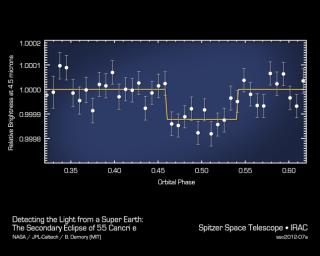
|
Magician of a Planet Disappears to Reveal Itself
- Click the image above for a larger view
- Full-Res JPEG (3000 x 2400) (332.6 kB)
- Full-Res TIFF (3000 x 2400) (21.6 MB)
Caption:
This plot of data from NASA's Spitzer Space Telescope reveals the light from a "super Earth" called 55 Cancri e. The planet is the smallest yet, beyond our solar system, to reveal its direct light. Super Earths are more massive than Earth but lighter than gas giants like Neptune. While this planet is not habitable, the observations are an important milestone toward being able to eventually perform a similar technique on even smaller, potentially Earth-like planets.
The plot shows how the infrared light from the 55 Cancri system, both the star and planet, changed as the planet passed behind its star in what is called an occultation. When the planet disappeared, the total light dropped, and then increased back to normal levels as the planet circled back into view. The drop indicated how much light came directly from the planet itself. This type of information is important for studying the temperatures and compositions of planetary atmospheres beyond our own.
Background Info:
JPL manages the Spitzer Space Telescope mission for NASA's Science Mission Directorate in Washington. Science operations are conducted at the Spitzer Science Center at the California Institute of Technology (Caltech) in Pasadena. Data are archived at the Infrared Science Archive housed at the Infrared Processing and Analysis Center at Caltech. Caltech manages JPL for NASA.
For more information about Spitzer, visit:
http://www.nasa.gov/spitzer
and
http://spitzer.caltech.edu
.
Cataloging Keywords:
| Name | Value | Additional Values |
|---|---|---|
| Target | 55 Cancri | |
| System | 55 Cancri | |
| Target Type | Exoplanet | |
| Mission | Spitzer Space Telescope | |
| Instrument Host | Spitzer Space Telescope | |
| Host Type | Space Telescope | |
| Instrument | Infrared Array Camera (IRAC) | |
| Detector | ||
| Extra Keywords | Atmosphere, Color, Infrared, Occultation | |
| Acquisition Date | ||
| Release Date | 2012-05-08 | |
| Date in Caption | ||
| Image Credit | NASA/JPL-Caltech/MIT | |
| Source | photojournal.jpl.nasa.gov/catalog/PIA15621 | |
| Identifier | PIA15621 | |
